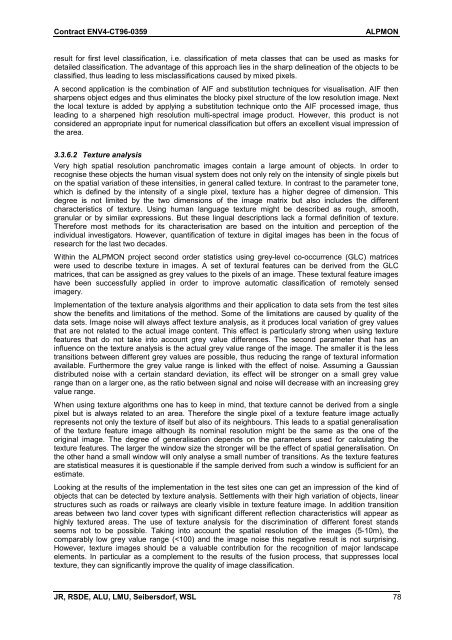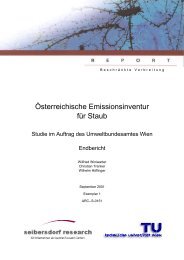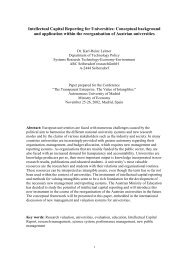ALPMON FINAL REPORT - ARC systems research
ALPMON FINAL REPORT - ARC systems research
ALPMON FINAL REPORT - ARC systems research
You also want an ePaper? Increase the reach of your titles
YUMPU automatically turns print PDFs into web optimized ePapers that Google loves.
Contract ENV4-CT96-0359 <strong>ALPMON</strong><br />
result for first level classification, i.e. classification of meta classes that can be used as masks for<br />
detailed classification. The advantage of this approach lies in the sharp delineation of the objects to be<br />
classified, thus leading to less misclassifications caused by mixed pixels.<br />
A second application is the combination of AIF and substitution techniques for visualisation. AIF then<br />
sharpens object edges and thus eliminates the blocky pixel structure of the low resolution image. Next<br />
the local texture is added by applying a substitution technique onto the AIF processed image, thus<br />
leading to a sharpened high resolution multi-spectral image product. However, this product is not<br />
considered an appropriate input for numerical classification but offers an excellent visual impression of<br />
the area.<br />
3.3.6.2 Texture analysis<br />
Very high spatial resolution panchromatic images contain a large amount of objects. In order to<br />
recognise these objects the human visual system does not only rely on the intensity of single pixels but<br />
on the spatial variation of these intensities, in general called texture. In contrast to the parameter tone,<br />
which is defined by the intensity of a single pixel, texture has a higher degree of dimension. This<br />
degree is not limited by the two dimensions of the image matrix but also includes the different<br />
characteristics of texture. Using human language texture might be described as rough, smooth,<br />
granular or by similar expressions. But these lingual descriptions lack a formal definition of texture.<br />
Therefore most methods for its characterisation are based on the intuition and perception of the<br />
individual investigators. However, quantification of texture in digital images has been in the focus of<br />
<strong>research</strong> for the last two decades.<br />
Within the <strong>ALPMON</strong> project second order statistics using grey-level co-occurrence (GLC) matrices<br />
were used to describe texture in images. A set of textural features can be derived from the GLC<br />
matrices, that can be assigned as grey values to the pixels of an image. These textural feature images<br />
have been successfully applied in order to improve automatic classification of remotely sensed<br />
imagery.<br />
Implementation of the texture analysis algorithms and their application to data sets from the test sites<br />
show the benefits and limitations of the method. Some of the limitations are caused by quality of the<br />
data sets. Image noise will always affect texture analysis, as it produces local variation of grey values<br />
that are not related to the actual image content. This effect is particularly strong when using texture<br />
features that do not take into account grey value differences. The second parameter that has an<br />
influence on the texture analysis is the actual grey value range of the image. The smaller it is the less<br />
transitions between different grey values are possible, thus reducing the range of textural information<br />
available. Furthermore the grey value range is linked with the effect of noise. Assuming a Gaussian<br />
distributed noise with a certain standard deviation, its effect will be stronger on a small grey value<br />
range than on a larger one, as the ratio between signal and noise will decrease with an increasing grey<br />
value range.<br />
When using texture algorithms one has to keep in mind, that texture cannot be derived from a single<br />
pixel but is always related to an area. Therefore the single pixel of a texture feature image actually<br />
represents not only the texture of itself but also of its neighbours. This leads to a spatial generalisation<br />
of the texture feature image although its nominal resolution might be the same as the one of the<br />
original image. The degree of generalisation depends on the parameters used for calculating the<br />
texture features. The larger the window size the stronger will be the effect of spatial generalisation. On<br />
the other hand a small window will only analyse a small number of transitions. As the texture features<br />
are statistical measures it is questionable if the sample derived from such a window is sufficient for an<br />
estimate.<br />
Looking at the results of the implementation in the test sites one can get an impression of the kind of<br />
objects that can be detected by texture analysis. Settlements with their high variation of objects, linear<br />
structures such as roads or railways are clearly visible in texture feature image. In addition transition<br />
areas between two land cover types with significant different reflection characteristics will appear as<br />
highly textured areas. The use of texture analysis for the discrimination of different forest stands<br />
seems not to be possible. Taking into account the spatial resolution of the images (5-10m), the<br />
comparably low grey value range (




